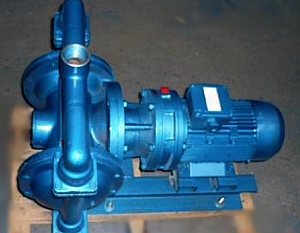What is the difference between a centrifugal pump and a diaphragm pump?
Centrifugal pumps and diaphragm pumps are two different types of pumps with distinct operating principles, advantages, and applications. Understanding their differences can help you choose the right pump for your specific needs. In this article, we will compare these two pump types and highlight their respective features, advantages, and limitations.
Centrifugal Pumps
Operating Principle
Centrifugal pumps use a rotating impeller to move fluid. The impeller accelerates the fluid outward, creating a centrifugal force that pushes the fluid through the pump casing and into the discharge outlet.Flow and Pressure
Centrifugal pumps are best suited for applications that require high flow rates and moderate pressure. The flow rate can vary depending on the impeller's speed and design.Efficiency
Centrifugal pumps are generally efficient when handling low-viscosity fluids, such as water or thin liquids. They may become less efficient when pumping high-viscosity fluids.Applications
These pumps are commonly used in water supply systems, HVAC systems, agricultural irrigation, and industrial processes involving low-viscosity fluids.Diaphragm Pumps
Operating Principle
Diaphragm pumps use a flexible diaphragm that moves back and forth to create a vacuum, drawing fluid into the pump chamber and then pushing it out through the discharge outlet.Flow and Pressure
Diaphragm pumps are capable of handling low to moderate flow rates and pressures. They can operate at a relatively low flow rate while maintaining a constant pressure.Efficiency
Diaphragm pumps excel in handling high-viscosity fluids and can effectively pump fluids with solid particles, abrasive materials, or gases.Applications
These pumps are widely used in industries such as chemical processing, pharmaceuticals, food and beverage, and wastewater treatment.Key Differences
Operating Principle
Centrifugal pumps rely on a rotating impeller to move fluid, while diaphragm pumps use a reciprocating diaphragm to generate flow.Fluid Handling
Centrifugal pumps are better suited for low-viscosity fluids, whereas diaphragm pumps are capable of handling high-viscosity fluids, gases, and slurries.Efficiency
Centrifugal pumps are generally more efficient for moving low-viscosity fluids at high flow rates. Diaphragm pumps are more efficient when handling high-viscosity fluids at lower flow rates.Pressure and Flow Control
Centrifugal pumps are typically less precise in controlling flow and pressure. Diaphragm pumps offer more precise control, making them suitable for applications requiring accurate dosing and flow rates.Maintenance
Diaphragm pumps generally require more maintenance due to the wear and tear on the diaphragm. Centrifugal pumps, on the other hand, are relatively low maintenance.Seal Types
Centrifugal pumps require mechanical seals to prevent leakage, which may need regular maintenance. Diaphragm pumps are typically seal-less, reducing the risk of leakage.Applications
Centrifugal pumps are commonly used in water supply, irrigation, and other general fluid transfer applications. Diaphragm pumps are suitable for specialized applications such as chemical handling, dosing, and slurry transport.Conclusion
In summary, centrifugal pumps and diaphragm pumps serve different purposes and are suitable for different types of applications. Centrifugal pumps are well-suited for high-flow, low-viscosity applications, while diaphragm pumps are ideal for precise control of high-viscosity fluids and delicate handling of gases and abrasive materials.
PEARL Pump, a leading supplier of diaphragm pumps in China, offers a range of high-quality products designed to meet the diverse needs of various industries. If you require reliable and efficient diaphragm pumps for your operations, consider PEARL Pump as your trusted supplier.
- PEARL PUMP integrated prefabricated pumping station - domestic sewage collection in Mianyang, China![ 2024-04-11 ]
- Integrated prefabricated pump station--Shuangliu Airport installation site![ 2023-06-18 ]
- Integrated prefabricated pumping station - installation site of rainwater and sewage collection and improvement project![ 2023-05-07 ]
- Prefabricated pump station on-site installation site![ 2024-04-14 ]
- Pengshan integrated prefabricated pump station is loaded and shipped![ 2019-09-09 ]
- The first sprinkler irrigation system - Agricultural Expo Park installation and commissioning site![ 2021-12-20 ]
- Large prefabricated pumping station - rainwater and sewage collection and improvement project![ 2024-04-13 ]
- 3.8m*16.3m large integrated prefabricated pumping station - Chengdu Railway Station - Rainwater and Sewage Renovation Project![ 2024-04-13 ]
- PEARL PUMP prefabricated pump station--Hubei, China![ 2024-04-10 ]
- Prefabricated pumping station installed in Sichuan, China completed![ 2024-04-14 ]







